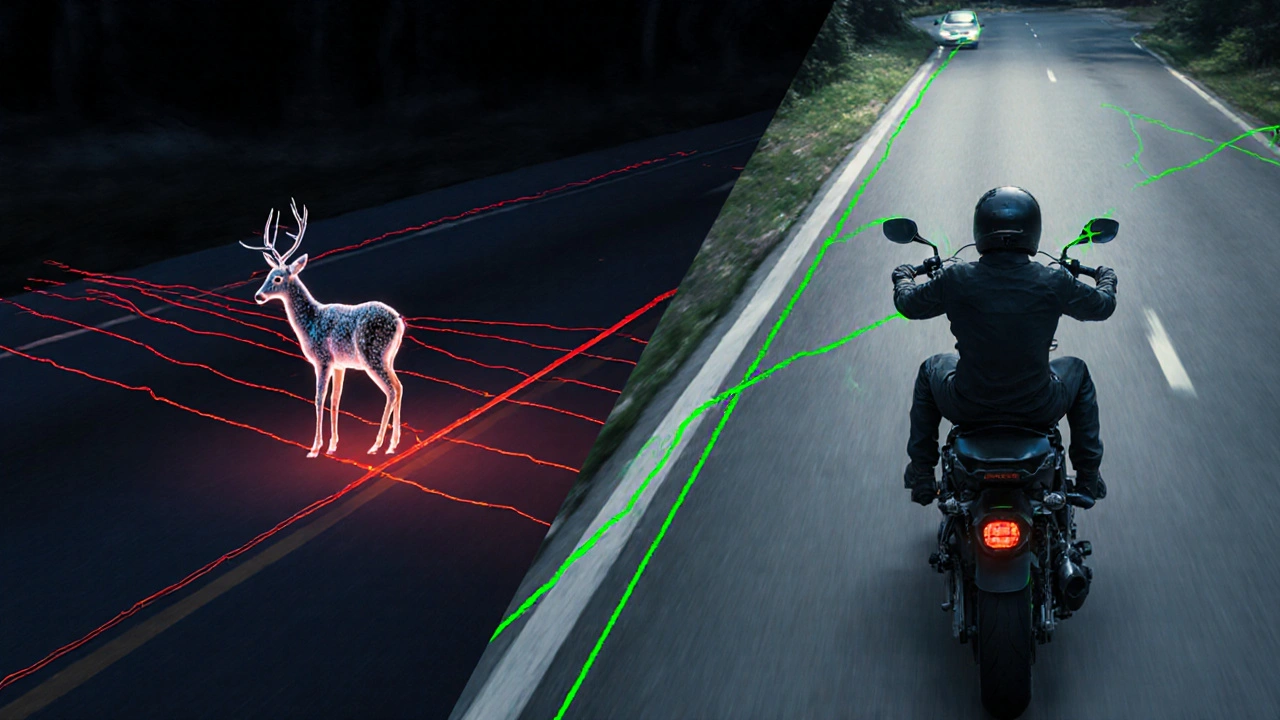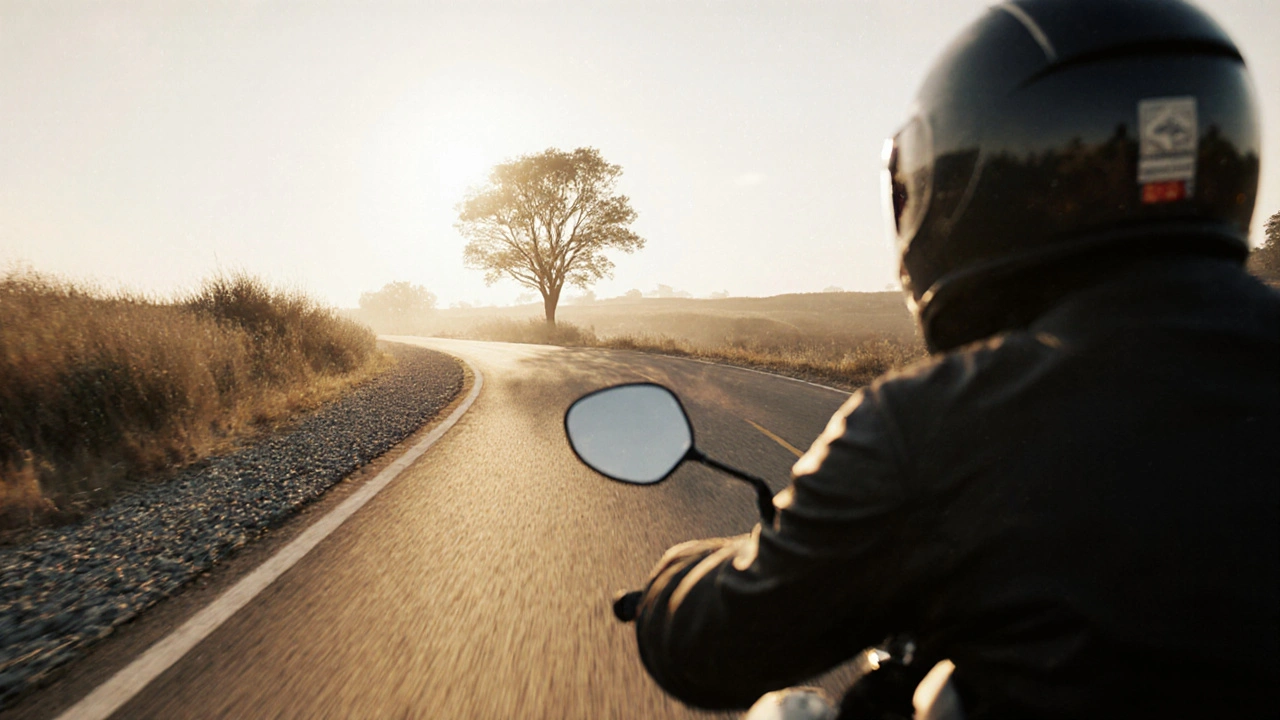Ever felt like your motorcycle is pulling you toward something you don’t want to hit? A parked car, a pothole, or even a deer on the shoulder? That’s not your bike acting up-it’s your brain. This is called target fixation, and it’s one of the most common causes of motorcycle crashes-even among experienced riders.
Target fixation isn’t about losing control of the handlebars. It’s about where your eyes go. Your brain follows your gaze. If you stare at the guardrail, your bike will head toward it. If you lock onto the car ahead that’s braking suddenly, you’ll likely hit it. You don’t need more strength. You need better focus.
Why Your Eyes Are the Problem
Your motorcycle doesn’t turn where you look-it turns where you look and where you lean. But if your eyes fixate on an obstacle, your body naturally leans toward it. It’s a hardwired reflex. Studies from the Motorcycle Safety Foundation show that over 60% of single-vehicle crashes involving motorcycles happen because the rider stared at the hazard instead of the escape path.
Think about it: when you’re riding and suddenly see a gravel patch ahead, what’s your first reaction? You freeze, your grip tightens, and your eyes lock on the gravel. Your brain thinks, Don’t hit that. But your bike doesn’t hear that. It only hears where you’re looking.
It’s not fear. It’s biology. Your visual system is designed to prioritize threats. That’s useful in a forest when a bear shows up. Not so useful when you’re carving through a curve and a loose drain cover catches your eye.
How to Break the Fixation Cycle
The fix isn’t to stop looking at hazards. It’s to look past them. Here’s how:
- Scan ahead, not down. Your eyes should be 10 to 15 seconds ahead of your bike. That’s about 150 to 200 feet on a highway. At city speeds, that’s two or three car lengths ahead. If you’re staring at the asphalt right in front of your front wheel, you’re already too late.
- Use the ‘look-through’ technique. When approaching a bend, pick a point on the other side of the turn-like a sign, a tree, or a lamp post-and focus on that. Your bike will naturally follow your gaze. Don’t look at the edge of the road. Look at the open space beyond it.
- Train your peripheral vision. You don’t need to turn your head to see everything. Practice noticing things in your side view without shifting your gaze. A car pulling out? You’ll catch it in your periphery. A child running toward the street? Your peripheral vision picks it up before your central vision does.
- Use the ‘point of no return’ rule. Before every turn, intersection, or hazard, ask yourself: If I don’t act now, where will I be in two seconds? If the answer is in the ditch, you’re already fixated. Reset your focus immediately.
One rider I met in Bristol-Dave, a 12-year veteran-used to crash every winter on wet roundabouts. He’d stare at the painted lines, and his bike would slide toward them. He started practicing the look-through technique. He picked a point on the curb beyond the turn, not the wet line. Within two weeks, his crashes stopped. He didn’t change his tires. He didn’t slow down. He just changed where he looked.
Scanning Patterns That Save Lives
Good riders don’t stare. They scan. Here’s a simple pattern you can use every time you ride:
- Far ahead: Look 150+ feet down the road. What’s coming? A car merging? A stopped truck? A child on a bike?
- Mid-range: Check your immediate path-10 to 50 feet ahead. Potholes? Debris? Oil slicks?
- Close range: Glance at your mirrors every 5 to 8 seconds. What’s behind you? Are they closing in? Are they distracted?
- Check blind spots: Before changing lanes, turn your head. Don’t just rely on mirrors. Your eyes need to physically confirm what’s there.
This isn’t a checklist you do once. It’s a rhythm. Like breathing. If you’re not scanning, you’re not riding safely. Even at low speeds.
Try this drill: Next time you’re stopped at a red light, don’t just stare at the car in front. Look up. Scan the intersections on both sides. Check the rooftops for people leaning out. Watch the pedestrians. Notice the traffic light timing. You’re not wasting time-you’re building awareness.

What Happens When You Fixate
Target fixation doesn’t just make you crash. It makes you slow down, jerk the handlebars, and panic. You might even forget to brake. I’ve seen riders swerve wildly to avoid a cat-only to hit a tree because they never looked away from the cat.
It’s not just about physical danger. It’s mental. Fixation creates tunnel vision. Your brain shuts out everything else. You stop processing. You stop thinking. You become a passenger in your own ride.
And here’s the worst part: you won’t even realize it’s happening until it’s too late. That’s why training is so critical. You have to rewire your reflexes.
Training Your Brain to Look Where You Want to Go
You can’t fix target fixation with just one ride. You need practice. Here’s how to train:
- Use cones or markers on empty roads. Set up three cones in a straight line. Ride toward them. At the last cone, quickly shift your gaze to a point 20 feet beyond it. Repeat. Your bike will follow your eyes, not the cones.
- Practice on quiet roads first. Find a stretch with no traffic. Ride slowly. Focus on picking a distant point and holding your gaze there, even if there’s a ditch or a curb right next to you.
- Use the ‘mirror and look-ahead’ drill. While riding, look ahead for 5 seconds. Then check your mirror for 2 seconds. Then back ahead. Do this for 10 minutes. It trains your brain to switch focus without losing awareness.
- Record your rides. Use a helmet cam. Watch it later. Where were your eyes? Were you staring at the road surface? Or were you looking where you wanted to go?
One rider in Wales told me he practiced this drill every morning before work. He’d ride 10 minutes on a quiet lane, just focusing on looking past every pothole. After a month, he said he felt like he had a sixth sense for danger. He didn’t avoid hazards. He avoided fixating on them.
What to Do When You Catch Yourself Fixating
It happens to everyone-even the best riders. The key is catching it early.
If you feel your eyes locking onto something dangerous:
- Take a quick breath. It resets your nervous system.
- Say out loud: “Look past it.”
- Find a safe target 20 feet beyond the hazard. A sign, a car’s tail light, a tree.
- Hold that gaze until you’re past the hazard. Don’t look back.
This isn’t magic. It’s muscle memory. The more you do it, the faster your brain learns to do it automatically.

Common Myths About Target Fixation
Let’s clear up some misunderstandings:
- Myth: “I just need to look harder at the road.”
Truth: Looking harder at the road means staring at the surface. That’s the problem. You need to look through the road to the space beyond. - Myth: “Slowing down fixes it.”
Truth: Slowing down gives you more time to fixate. It doesn’t stop the reflex. You can still crash slowly. - Myth: “Only new riders get this.”
Truth: Experienced riders get it worse. They’re faster, more confident, and less likely to question their instincts. - Myth: “It’s just a visual thing.”
Truth: It’s neurological. Your motor cortex follows your visual input. It’s not a choice-it’s a reflex.
Real-World Scenarios
Let’s say you’re riding on a country road. A deer runs out and freezes in the middle of the lane.
Fixation response: You lock eyes on the deer. Your body tenses. You don’t brake. You don’t steer. You just stare. You hit it.
Scanning response: You see the deer, acknowledge it, and immediately shift your gaze to the left shoulder-where you have space. You brake gently, lean slightly left, and ride past it. The deer bolts. You’re fine.
Another example: You’re in traffic. A car ahead suddenly brakes. You’re about to rear-end them.
Fixation response: You stare at their brake lights. Your brain thinks, They’re stopping, I’m going to hit them. You don’t react fast enough.
Scanning response: You see the brake lights, then immediately look to the left lane-checking for space to move. You hit your brakes and shift lanes before you even think about it.
The difference isn’t skill. It’s focus.
Final Thought: You Ride With Your Eyes
Your motorcycle is an extension of your body. But your eyes are the control panel. If you stare at the cliff, you’ll go over it. If you look at the open road, you’ll stay on it.
Target fixation isn’t something you overcome once. It’s something you manage every ride. Every turn. Every intersection.
So next time you ride, ask yourself: Where am I looking? If the answer isn’t where you want to go, change it. Right now.
What exactly is target fixation on a motorcycle?
Target fixation is when a rider’s eyes lock onto a hazard-like a car, pothole, or barrier-and their motorcycle unintentionally steers toward it. It’s a neurological reflex, not a lack of skill. Your brain follows your gaze, and your bike follows your brain. The more you stare at something dangerous, the more likely you are to hit it.
Can slowing down prevent target fixation?
Slowing down gives you more time, but it doesn’t stop target fixation. You can still crash slowly if you’re staring at the obstacle. The real fix is changing where you look-not how fast you go. A rider going 30 mph who looks past a hazard will avoid it. A rider going 10 mph who stares at it will still hit it.
Is target fixation only a problem for beginners?
No. Experienced riders are actually more at risk. They ride faster, trust their instincts more, and rarely question their visual habits. Many don’t even realize they’re fixating until after a near-miss or crash. That’s why training focus is just as important for veterans as it is for new riders.
How can I train myself to avoid target fixation?
Practice the look-through technique on quiet roads. Set up cones or markers and ride toward them, then shift your gaze to a point beyond. Use a helmet cam to review where your eyes go. Do the mirror-and-look-ahead drill: look ahead for 5 seconds, check your mirror for 2, then back ahead. Repeat daily. It rewires your reflexes.
What’s the best way to scan while riding?
Use the 3-zone scan: far ahead (150+ feet), mid-range (10-50 feet), and close range (mirrors and blind spots). Check mirrors every 5-8 seconds. Look for movement, not just static objects. Scan intersections before you enter them. Your eyes should be moving constantly-not locked on one spot.
Can helmet cameras help with target fixation?
Yes. Watching your ride footage shows you exactly where your eyes go. Most riders think they’re scanning, but the video proves they’re staring at the road surface or hazards. It’s eye-opening. Use it to spot patterns and correct them.

